(DISCLAIMER: The author of this blog owns none of the properties depicted below. All images used below are property of their respective companies unless stated otherwise.)
Original Airdate: October 8, 2005
Writer: Steven Melching
Director: Anthony Chun
So here we are – The Batman‘s second attempt at a reformation story, and its last Ventriloquist episode. Much as I love him/them, I have to admit that’s probably for the best, since there’s really only two stories you can do with the Ventriloquist: the debut (which may or may not double as an origin) and the rehabilitation attempt.
This is an accusation more commonly leveled at Two-Face, and while I disagree in that case, I can’t deny that Arnold Wesker is in many ways a poor man’s Harvey Dent. Like Harvey, he’s a fundamentally good man plagued by an evil split-personality, but there’s no rise-and-fall arc, and far less complexity. Arnold and Scarface have nothing in common – to the point of using different names and different bodies – so their story is less “man confronts his darker side, compromises with it through random chance” and more “man gets pushed around by douchebag he just happens to share a brain with”.
And that’s when Scarface isn’t being portrayed as a literal demon possessing poor Arnold.

Long story short, Ventriloquist reform stories tend to go through the same beats no matter who writes them – you read one, you’ve read ’em all. That Other Show’s take stands out with a somewhat unconventional ending, but that’s about it. Let’s see whether The Batman can rise to the occasion.
Now, I think we can all agree that while Steven Melching is exactly the wrong guy to get for deep, introspective character pieces, he is exactly the right guy to get for an actual Batman/Scarface fight scene. Which is good, because apparently the Ventriloquist couldn’t afford any thugs for our cold-open caper.
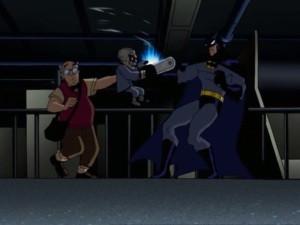
Oh, tiny wooden Leatherface doesn’t do it for you? How ’bout tiny wooden Pyro?

Yeah, where his animated predecessor quaked at mere termites, this S.O.B. will risk burning himself to a crisp if it means seeing Batman dead (I’m especially tickled by how few fucks the episode gives about where he keeps the thing). But never fear – Batman’s got his own little friend to even the odds.

Sorry, Babs, but Dan Castellaneta ate up most of this episode’s budget, so the showrunners had to get someone a little more… economical. Don’t worry, though – you have my sincerest assurance it’s another beloved member of Batman’s supporting cast!

Ahhh, the giant penny. As Batcave trophies go, it might not be quite as cool as the robot dinosaur, but it’s got a richer history. It debuted alongside the Penny Plunderer, a villain so lame that he dies literally every time he gets rebooted, but Max Allan Collins later tied it to Two-Face, and That Other Show famously picked up the ball and ran with it. Intentional or otherwise, this show linking it to Arkham’s other one-man duo is a nice echo.*
In another fun parallel with Harvey, Arnold somehow survives getting squashed under a metric ton of metal. Next we see him, he’s been put into the Worst Therapy Circle Ever by none other than Hugo Strange.

Yes, the bad doctor is back – and in Frank Gorshin’s last voice-acting gig, to boot. I still regret that cancer snuffed Gorshin out just as Strange’s story was kicking into high gear, especially since Gorshin’s voice-work here is the best he’s done for The Batman. Just listen to the way he growls “radical treatment”. Brrr.

Here’s where we hit the first beat: the tragic separation of Arnold and Scarface. In most other takes on this story, this part is merely implied, but Chun’s direction is good enough to make it more unsettling than “three guys kidnap a doll” has any right to be.**
Once Scarface is out of the picture, we follow every step of Arnold’s long, painful, months-long road to normahahaha yeah right. We’ve gone almost five minutes without an explosion, so here’s Bruce showing that cannery from last episode who’s boss!
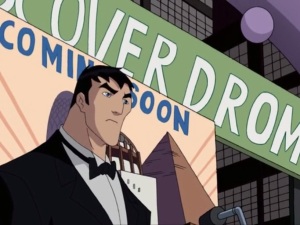
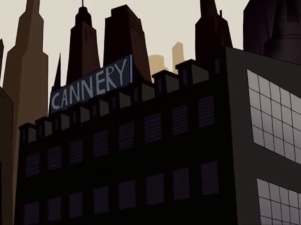


On the bright side, this cues a much smoother timeskip than the one from “Meltdown”. See, Bruce intends to replace the cannery with a children’s museum, and it’s only after that museum has leapt off the “Coming Soon” poster and into reality that Arnold gets released from Arkham. It might be sappy, but it gets points with me.
Points it instantly loses when it also brings this show to a low not seen since “Pets”.

So yeah, I’m not gonna shed too many tears over what happens to the museum later in this ep. But for now, let’s focus on the second beat: Bruce taking a personal interest in Arnold’s reformation.
Exactly how Batman reacts to his villains reforming varies wildly across stories: sometimes he’ll personally get them parole and/or new jobs, sometimes he’ll stalk and harass them so badly you’d think he wants them to relapse, and sometimes he just doesn’t bother keeping any tabs. What I find interesting is that this lighter-and-goofier Batman is neutral, leaning towards the second. His counterpart in “Double Talk”, made for That Other Show’s darkest season? Went for the first with zero reservation.
Maybe this Batman has more reason to think of the Ventriloquist as genuinely dangerous, but it doesn’t make things any less awkward when he tries to stop Arnold from pulling a “job” and winds up with this.
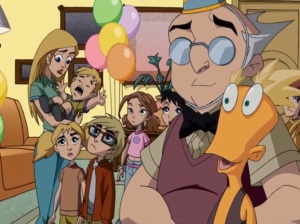
Oh, would you look at that, we’re already on the third beat: reformed!Arnold gets a job as a legit puppeteer.
The job itself isn’t that big a shock. Since Arnold is typically an out-of-shape senior citizen with exactly one marketable skill that won’t attract Batman’s fist, “Double Talk” is actually the odd man out for not including it (though this Arnold does have options in the giant robot market). But there’s a deeper parallel here: in each case, Arnold keeps up the whole puppets-are-people shtick way more than he should need to for a paycheck.

It’s almost like Arnold’s brain is hardwired to need a companion in a wooden body; the only thing that can change is how law-abiding the companion is. This can be either tragic or sinister, depending on how cynical you want to be. Is Arnold so desperate for friends, but so ill-suited to making them, that he’ll settle for a hunk of wood and felt? Or does he feel, deep down, that the puppets are the perfect friends because they’re only extensions of his own mind (and thus can’t go against him)? And come to think of it, if he’s still got either mindset, should Arkham have let him out at all?***
Well, I guess that last question is pointless here, because Arnold’s new friend Mr. Snoots was 100% Hugo Strange’s idea. The other half of that “radical treatment”, y’see.
Oh, by the way, you might’ve noticed the last pic has panels done in That Other Show’s old art-style. I forgot to mention this at the start, but That Other Show technically did this story twice – the other time being an annual for the tie-in comic. I bring this up because by the third act, this episode is going to become a fairly close… let’s be nice and say homage to that comic.
But for now, Melching drops a surprising amount of backstory on Arnold. Seems he was once the Jim Henson of Gotham, until his show got taken off the air (no word on whether Fred Friendship was involved) and he was forced to go on the road. This episode was made years before Jeff Dunham became a household name, so you can guess how Arnold’s luck turned out.

Then DID reared its ugly head, Arnold somehow became a criminal genius with zero experience, blah blah blah. This is a decent take on Arnold’s backstory, despite having 100% less prison, murder, and albatrosses than the comics, and even Bruce thaws a little when he sees it on Exposition News.
Buuut just to be safe, Bruce talks things over with that nice doctor in charge of Arnold’s therapy. Only then does he invite Arnold and Mr. Snoots to perform at the museum’s grand opening, where there’ll be lots and lots of priceless antiques on display.
Alright, Arnold’s gotten his fifteen minutes of happiness. Time to burn it all to the ground.

Okay, so maybe an outright Godfather parody would’ve been too much to sneak past BS&P, even if the “victim” was just a dummy. Nevertheless, this… is a pretty lame payoff to all of Chun’s build-up. It might be enough if Arnold’s little buddy looked more like a human being, but as-is, Mr. Snoots needs to be a lot more banged-up to pull anything more than a “… so what?” out of me.
What comes after, though, is glorious. Put your hands together for the fourth beat: Arnold and Scarface’s joyous reunion.

Real talk: I’ve ragged on this episode a lot, but I’m tempted to declare it superior to “Double Talk” based on this scene alone. America’s familiarity with Dan Castellaneta has bred no little contempt for the man, which makes it easy to forget that given the right material, he can still voice-act the pants off everyone else in the room.
While the build-up behind this scene – even before the Mr. Snoots reveal – is inferior to its predecessor’s, Arnold’s sheer, undiluted rage makes up for it and then some. Every other take on the reunion has Arnold become a sniveling, whimpering wreck the second he glimpses Scarface, and while that’s certainly understandable, I find this take even more depressing. Arnold is just that damn desperate for a normal life, but in the end, as his screams finally break down into sobs, he knows he has no choice.
No choice at all.
That said, there’s some real missed opportunity in Scarface’s retort, which is boilerplate “RAH YOU LEFT ME BEHIND BARS YER GONNA PAY” stuff. There’s nothing wrong with that, but he begins his rant with “You owe me!”, and… how much cooler would it have been for him to go on about how he kept a roof over Arnold’s head after the “legit” life crapped out? The Batman‘s take on Arnold is the only one who initially turned to crime out of desperation, not just because his headmate felt like it.
Speaking of crime, it’s time Arnold was dragged kicking and screaming back into it. And Rhino and Mugsy are here to-
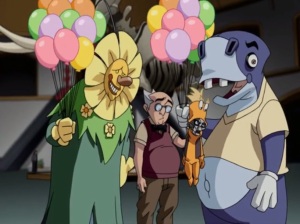
Christ on a…
You know what? I take back what I said about Mr. Snoots’ fate. Scarface going Buffalo Bill on his ex-replacement is way worse than anything I could think of. Not even his goons’ stupid disguises can lighten things up.
At the same time, given they’d just aired a TV special about Arnold’s history, you’d think someone at the grand opening would be suspicious. Melching apparently thought the same thing, since he takes pains to at least get Bruce away from the party… by having Bruce change into Batman just to take a call from the police.

About what?

… moving on. Mugsy and Rhino might get some extra padding out of their “disguises”, but as anyone who’s worked at Disneyland will tell you, those things are a bitch to move in and have zero peripheral vision. And Scarface’s flamethrower only ends up roasting everything besides Batman. So it’s time for desperate measures.



By the time Batman gets back up, the bad guys are long gone, and the whole museum is trashed which means there’s a big, fat insurance payout waiting for Bruce Wayne. Now back to square one, Batman goes off to investigate Arnold’s apartment, while Scarface and friends reconvene on the soundstage for Arnold’s old TV show, where…

… okay, I’ve watched this scene a dozen times and I still don’t know how to feel about it. Like any good gangster, Scarface is constantly looking for backstabbers, and he somewhat correctly figures that only a tip could’ve gotten Batman to the museum that fast. For his next amazing deduction, he decides Arnold is the tipster.
In concept, nothing here is out-of-character for Scarface – in fact, this exact scenario formed the climax of his debut on That Other Show. But that Scarface didn’t take his cues from Snidely Whiplash, and more importantly, didn’t put himself in the line of fire. Between the inherent lameness of getting run over by a prop train that tops out around 1 MPH and Rhino and Mugsy changing back into their mascot disguises for no fucking reason, it would be easy to write off this whole scene as Melching no longer giving a crap.
But what Scarface says next really makes me think.

On the face of things, it’s a cute shout-out to Al Pacino’s other genre-defining gangster. But look a little deeper, and you might realize this is the only time The Batman‘s Scarface has addressed Arnold by name – something that’s incredibly rare even in the comics. After all, a tough-as-nails crime boss has appearances to keep up… until he doesn’t need them anymore.
Suddenly, what looks like an underthought deathtrap starts looking like a deliberate murder-suicide. Again, it’s very in-character for Scarface to think he can survive past Arnold (which he actually kind of did in the comics), but in that case, why not make Arnold set him beside the tracks? It’s not like he needs to be on Arnold’s hand to “talk” – being a ventriloquist literally means you can throw your voice wherever you want!
Am I reading way too hard into a cartoon made with somewhere around 1% of the diligence and care showered upon That Other Show? Yes, yes I am. But the idea that Scarface would abandon his loot and his life because he’s just that shaken by his #1 flunky (and the closest thing he has to a friend…?) genuinely defying him? There’s something almost poignant about that. And that’s without getting into the possibility that Scarface is finally realizing he’s been at Arnold’s mercy all along, and can’t bring himself to face it.
Mind you, not all of the above holds up equally well by the time we get to the fifth and last beat: Batman spurring Arnold to kick Scarface to the curb once and for all.
I’m kind of cheating, since this only other story with this beat is “Double Talk”. But it’s probably 99% the reason Arnold gets any respect at all, so here – witness it in all its glory before Warner Bros goes on another banning spree.
Alas, unlike his predecessor, this Arnold can’t quite muster up the backbone to save himself. And you know what? I can’t really blame him. There’s something indescribably cathartic about seeing a man slaughter his lifelong tormentor, sure, but this Arnold has neither the luxury of a gun nor the freedom of using one. What’s more, Rhino and Mugsy are still in the room, and they’ve still got zero qualms about finishing the job (more loot for themselves, after all).
But wait, you say. If Arnold can’t even act to save himself, how’d he drop a dime on Scarface’s splintery ass? Well…

This is the “homage” to That Other Show’s tie-in comic I mentioned earlier. Seriously, it’s the exact same twist.

Neither version really trumps its competitor in the logic department, but the comic was a short, sleek little yarn that mainly used the twist as black (and very surreal) comedy. This episode, on the other hand, had twenty-two minutes to play around with, so would a little more setup have been too much to ask? And no, Batman poking around in Arnold’s apartment doesn’t count – all he found was Mr. Snoots’ “corpse” in a box!****
Speaking of which, it looks like Scarface didn’t skin Mr. Snoots after all, which means Arnold just keeps a Snoots costume around for some reason. And also that I’m gonna have to take back my take-back.

That said, I’ve no problem with the concept of Arnold having a “good” version of Scarface. It’s a beautiful twist on the idea that Harvey Dent uses his coin as a weapon against his inner demons, and even if “fight crazy with crazy” isn’t your idea of successful/ethical rehabilitation, it would at least be a refreshing story development.
And what happens next… actually kind of backs that up.

Okay, first off, Scarface still having his chainsaw introduces a whole new possibility – that this whole deathtrap was only meant to intimidate Arnold, not kill him. Given that the train is moving at roughly the speed it takes me to finish a term paper, it’s actually not that dumb a plan. Arnold thinks death is barreling down on him, sure, but it would only take a few seconds to cut him free, at which point whatever backbone Arkham gave him would be long gone.
But if that wasn’t what Scarface had in mind, well… what better illustration of “fight crazy with crazy” is there? If a puppet can shelter and strengthen Arnold’s evil, abusive alternate personality, well, who’s to say another puppet can’t do the same for his good traits?
So of course, Thomas the Tank Engine’s inbred uncle strangles the whole thing as soon as it gets out of the crib.

To no one’s surprise, Arnold immediately begins sobbing over “the most special guy… in the whole wide wonderful world”. And to his credit, instead of wrapping things up with another snide one-liner, Melching has Batman say something genuinely insightful.
“If you’re referring to Mr. Snoots… there may be hope for you yet.”
The end? Not quite. After all, the real villain’s still at large.

Yeah, surprise – Arnold’s failed reformation was all Hugo’s fault. And in the episode’s last thirty seconds, the bad doctor comes close to stealing the whole damn show. Gorshin’s amazing voicework makes his confession to Batman feel unrepentantly blunt, yet also weaselly enough to not be too useful for the D.A.’s office.
“I had to put my treatment to the test, Batman. You know, to see if the criminal mind can ever really be cured.”
Does he mean every word? Or is he just a sadistic fuckstick tormenting the mentally ill because he thinks it’s funny? Either way, he’s become a shoo-in for the most disturbing villain in this show.
In every other take on Arnold’s reform, the ones responsible for sticking Scarface back in his life are people you’d expect to be villains – either his old gang, or jealous rivals. Now, Hugo didn’t come out of his last few appearances smelling like roses, but the idea of Arnold’s progress being sabotaged by his own doctor is still the most stomach-churning one. In this day and age, we’ve already learned to distrust cops and clergy and heads of state; when doctors are added to that list too, well… is there anyone left to trust?*****
Maybe this is why Batman (who is, after all, the son of a doctor) beats feet and leaves Hugo to his own devices so quickly. I know it’s the end of the episode and everything, but surely he could’ve given Hugo a harder warning than just “I’ll be watching you”? A warning that Hugo’s probably already forgotten by the time he turns back to the paddy-wagons.
I previously gave “Meltdown” the honor of “bleakest episode ever”, and I stand by it. But this episode is a solid contender for the silver. It hasn’t the claustrophobic direction of “Double Talk”, and its plot is much shaggier, but the combination of Castellaneta and Gorshin makes for an episode that’s still more tragic – and more haunting – than any Saturday-morning cartoon has the right to be. If nothing else, I think it’s a note Gorshin would’ve been proud to go out on.
Next: Gentlemen, start yourrrrrrr engines… for what may be the most shameless piece of shilling in the history of Batman!
* Melching even kept the most interesting fact about the penny: in all its debuts save one, it was an innocent bystander. Neither Batman nor the bad guy(s) built or owned it in any way, and if they use it at all it’s purely out of convenience. In other words: Batman straight-up stole the thing.
** That said, it would’ve been awesome if Melching somehow found a way to reference the Justice Lords’ rehabilitation plan.
*** In the comics, getting a new puppet (and a new split personality to match) is Arnold’s go-to coping strategy whenever he’s separated from Scarface. The big difference is that, generally speaking, the new puppets are every bit as evil.
**** Mind you, the comic was also written by Paul Dini, which may have lent it something of an advantage…
***** It’s worth noting that in “Double Talk”, Arnold’s old gang explicitly went to much further lengths to gaslight Arnold, like planting speakers in his room and hiring a midget to play a “living” Scarface. I’d like to think Hugo did the same thing here, but he probably didn’t; otherwise, Batman would have called him out on it.
Thanks for the review! Food for thought: you pointed out how Batgirl got left out of this episode. What if all the moments with Batman in this episode were replaced with Batgirl instead? Do you think the story would change at all? 🤔
LikeLike
Honestly, I pretty much agree with The World’s Finest that she wouldn’t have contributed anything.
LikeLike
The ending of this episode also puts Hugo’s role in “Meltdown” in a whole new light. Did Hugo genuinely want to cure Ethan from being Clayface? Or was Ethan just another one of his “experiments” to release and test out?
LikeLike
One of the tie-in comics actually elaborates (kinda) on the relationship between Hugo and Ethan. I’ll have to bring that out when we get to the next season.
LikeLike
Yeah, I remember that issue. It’s been a long time since I’ve re-read that.
LikeLike
Now I really want to see a Scarface/Quakemaster/Socko/Lola/Croaky/Mr. Snoots story someday.
LikeLike
Those slashes better represent “platonically interacts with”, buster.
LikeLike